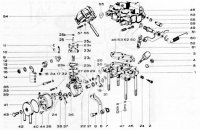honolulu's procedure - q's about it
i have written my question in bold
The short answer is "Hell Yes! You CAN synch your own carbs." And you should, too. I dunno if you're familiar with multiple carb synchronizing, so here's most of it. It assumes your engine will run at idle.
Cold engine, set valve lash .008 intake, .010 exhaust. Running engine, dwell 35 to 41 degrees (about .014 at points IIRC). Timing per spec on the flywheel ball at 1700 rpm with vacuum hoses disconnected and plugged.
The "poor man's" carb synchronizer is 8 feet of 1/8' diameter clear tubing. Costs about 15 cents per foot. Suck some ATF into it so that when hung in a loop, ends up, the ATF fills a U shape about 8 inches high on each side.
I have used the factory sychronizing device (probably NLA), and have THREE Uni-syn devices (about $30 each if I had paid for them) which have also been experienced with my current 3.0, my old 2500 4-door, and wife's Bavaria, and my old dual-carb '67 VW Type 3. Believe me, the poor man's tubing is just as good as any UniSyn, and BETTER than the factory tool, which works only at idle.
1. Disconnect the front-back carb linkage, at the rear carb, so the two operate independently and are no longer linked together. I also disconnected the link coming up from the bellcrank on the side of the block.
2. Remove the vacuum hoses on the left side of each carb (left is left, facing front of car). Hang the tubing in an "M" shape, from the open hood.
I am supposed to connect both ends of the 'M' to the vacuum hose outlet at the left and right carb?
Put a small weight at the middle of the M so it doesn't blow around too much. Pinch or kink the tubing so that when you start the engine, all the ATF doesn't run into one carb. If it runs away anyway, it won’t hurt, just refill ATF in the hose and set up the M with the engine stopped.
is the hose supposed to stay pinched throughout the procedure?
3. Start the engine, run at idle until warm and chokes are fully opened. If the carbs aren't balanced, the ATF will be higher on one leg of the M than the other. Adjust the idle SPEED screws on each carb linkage to get a 900 rpm idle, with the ATF at equal height on each leg of the M.
whenever i try to un-pinch one side of the 'M' the vacuum sucks it toward one of the carbs
4. Adjust the idle MIX screws at the right side carb bases, to lean best idle. Hint: lay a cloth over the valve cover which will be quite warm.
5. Go back and forth between front and back carbs, adjusting idle mix and idle speed, a couple times till all is well and you have a smooth idle at about 900 rpm. Okay, idle is done.
6. Now reconnect the linkage at the back carb (and bellcrank if disconnected). Idle speed should not change. If it does, adjust the little knurled wheel at the rear carb linkage until the ATF in the M doesn’t change with the carbs linked or no. Don't use other tweaks - just the knurled wheel.
7. Raise the engine rpm to about 2500 using the small vertical screw on the linkage between the front carb and valve cover. If the ATF shows imbalance, even it out using the little knurled wheel at the rear carb linkage
8. After balancing at 2500 rpm, back off the little vertical screw on the linkage until it doesn't touch, i.e., has no effect on engine rpm.
9. Shut off engine, remove M tubing, reconnect vacuum hoses. SMILE you've done it. That wasn't hard, was it? Think about going into business. Think again.







